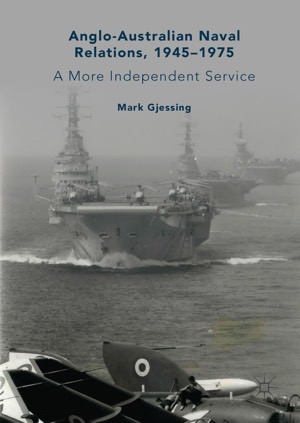
Anglo-Australian Naval Relations, 1945-1975: A More Independent Service. By Mark Gjessing. Palgrave Macmillan, London, 2018.
Reviewed by Alastair Cooper
THE Royal Australian Navy’s relationship with the Royal Navy is one of its most fundamental influences. Even in 2018, more than four decades after the events described in this book, many aspects of the Royal Australian Navy’s organisation and culture can be traced to the Royal Navy.
Like the relationship between the Australian and British nations, the relationship between their two navies was anything but static. Particularly after the Second World War there were constant changes and these had major effects on the Royal Australian Navy (RAN). As the title of this book suggests, by 1975 the RAN was in deed and in conception, a more independent service.
Mark Gjessing, a former member of the Royal Australian Navy, has produced an interesting and detailed account of the evolution in Anglo-Australian Naval Relation in the thirty years following Second World War. The book’s origins are in the author’s PhD thesis, which shows through in the detailed and thorough research evident from the footnotes and bibliography. While the book follows closely to the original PhD thesis, it reads well and the logical division of subject material makes it more approachable still.
The book covers personnel, equipment, organisation and operations, and sets each of these in the context of the historical and contemporary national relationships. The examination of each of these areas is logical and well-argued. The book’s account of the relationship through the 1960s and early 1970s is particularly worthwhile, as it traces the Australian implications of Britain’s attempts to integrate more closely with Europe, its withdrawal from East of Suez and the evolving Australia-United States relationship. The complexity, cost and difficulty of fundamental organisational change are evident in the account. The acquisition of the US CHARLES F. ADAMS class destroyers, the subsequent unsuccessful attempts to develop an Australian light destroyer (the DDL project) and consequent acquisition of the US OLIVER HAZARD PERRY class frigates are well described and have contemporary relevance.
The book is published by Palgrave Macmillan and the review hardback copy is well produced. The only obvious criticism of the publication is the lack of pictures which would have improved the overall result from a very good book to an excellent one. Particularly given the price (around A$95 for the hardcover and over A$80 for the Kindle edition from an initial online inspection) and the availability of large numbers of high-quality photographs, the omission is noteworthy, albeit one more for consideration by the publisher than author one suspects.
This book should be held by all Australian tertiary institutional libraries and internationally by all those with military history and international relations departments and courses. It will also be an important reference work for anyone researching post Second World War Australian military or naval affairs. Current members of the Royal Australian Navy will find the book an invaluable source of professional military education, for which it is highly recommended.



